Oxidation in Low Moisture Foods as a Function of Surface Lipids and Fat Content
Abstract
1. Introduction
2. Materials and Methods
2.1. Materials
2.2. Methods
3. Results
3.1. Differences in Lipid Oxidation between Surface and Total Lipids
3.2. Effect of Fat Concentration on Lipid Oxidation
4. Discussion
4.1. Differences in Lipid Oxidation between Surface and Total Lipids
4.2. Effect of Fat Concentrations on Lipid Oxidation
5. Conclusions
Author Contributions
Funding
Institutional Review Board Statement
Informed Consent Statement
Conflicts of Interest
References
- Chen, B.; McClements, D.J.; Decker, E.A. Minor Components in Food Oils: A Critical Review of their Roles on Lipid Oxidation Chemistry in Bulk Oils and Emulsions. Crit. Rev. Food Sci. Nutr. 2011, 51, 901–916. [Google Scholar] [CrossRef] [PubMed]
- Budilarto, E.S.; Kamal-Eldin, A. The supramolecular chemistry of lipid oxidation and antioxidation in bulk oils. Eur. J. Lipid Sci. Technol. 2015, 117, 1095–1137. [Google Scholar] [CrossRef] [PubMed]
- Faustman, C.; Sun, Q.; Mancini, R.; Suman, S.P. Myoglobin and lipid oxidation interactions: Mechanistic bases and control. Meat Sci. 2010, 86, 86–94. [Google Scholar] [CrossRef] [PubMed]
- Domínguez, R.; Pateiro, M.; Gagaoua, M.; Barba, F.J.; Zhang, W.; Lorenzo, J.M. A Comprehensive Review on Lipid Oxidation in Meat and Meat Products. Antioxidants 2019, 8, 429. [Google Scholar] [CrossRef]
- Amaral, A.B.; Silva, M.V.; Lannes, S.C.S. Lipid oxidation in meat: Mechanisms and protective factors—A review. Food Sci. Technol. 2018, 38, 1–15. [Google Scholar] [CrossRef]
- Barden, L.; Decker, E.A. Lipid Oxidation in Low-moisture Food: A Review. Crit. Rev. Food Sci. Nutr. 2016, 56, 2467–2482. [Google Scholar] [CrossRef]
- Mandić, A.I.; Sedej, I.J.; Sakač, M.B.; Mišan, A.C. Static Headspace Gas Chromatographic Method for Aldehyde Determination in Crackers. Food Anal. Methods 2013, 6, 61–68. [Google Scholar] [CrossRef]
- Bassiouny, S.S.; Hassanien, F.R.; El-Razik Ali, F.A.; El-Kayati, S.M. Efficiency of Antioxidants from Natural Sources in Bakery Products. Food Chem. 1990, 37, 297–305. [Google Scholar] [CrossRef]
- Kweon, M.; Slade, L.; Levine, H. Development of a Benchtop Baking Method for Chemically Leavened Crackers. I. Identification of a Diagnostic Formula and Procedure. Cereal Chem. 2011, 88, 19–24. [Google Scholar] [CrossRef]
- Barden, L.; Vollmer, D.; Johnson, D.; Decker, E.A. Impact of Iron, Chelators, and Free Fatty Acids on Lipid Oxidation in Low-Moisture Crackers. J. Agric. Food Chem. 2015, 63, 1812–1818. [Google Scholar] [CrossRef]
- Quast, D.G.; Karel, M. Effects of Environmental Factors on The Oxidation of Potato Chips. J. Food Sci. 1972, 37, 584–588. [Google Scholar] [CrossRef]
- Vu, T.P.; He, L.; McClements, D.J.; Decker, E.A. Effects of water activity, sugars, and proteins on lipid oxidative stability of low moisture model crackers. Food Res. Int. 2020, 130, 108844. [Google Scholar] [CrossRef]
- Buffo, R.A.; Probst, K.; Zehentbauer, G.; Luo, Z.; Reineccius, G.A. Effects of agglomeration on the properties of spray-dried encapsulated flavours. Flavour Fragr. J. 2002, 17, 292–299. [Google Scholar] [CrossRef]
- Soottitantawat, A.; Yoshii, H.; Furuta, T.; Ohkawara, M.; Linko, P. Microencapsulation by Spray Drying: Influence of Emulsion Size on the Retention of Volatile Compounds. J. Food Sci. 2003, 68, 2256–2262. [Google Scholar] [CrossRef]
- Vega, C.; Roos, Y.H. Invited review: Spray-dried dairy and dairy-like—Emulsions compositional considerations. J. Dairy Sci. 2006, 89, 383–401. [Google Scholar] [CrossRef]
- Kim, E.H.J.; Chen, X.D.; Pearce, D. Surface characterization of four industrial spray-dried dairy powders in relation to chemical composition, structure and wetting property. Colloids Surf. B 2002, 26, 197–212. [Google Scholar] [CrossRef]
- Drusch, S.; Berg, S. Extractable oil in microcapsules prepared by spray-drying: Localisation, determination and impact on oxidative stability. Food Chem. 2008, 109, 17–24. [Google Scholar] [CrossRef]
- Pikul, J.; Leszczynski, D.E.; Kummerow, F.A. Relative Role of Phospholipids, Triacylglycerols, and Cholesterol Esters on Malonaldehyde Formation in Fat Extracted from Chicken Meat. J. Food Sci. 1984, 49, 704–708. [Google Scholar] [CrossRef]
- Min, B.; Nam, K.; Cordray, J.; Ahn, D. Endogenous Factors Affecting Oxidative Stability of Beef Loin, Pork Loin, and Chicken Breast and Thigh Meats. J. Food Sci. 2008, 73, 439–446. [Google Scholar] [CrossRef]
- Igene, J.O.; Pearson, A.M.; Dugan, L.R.; Price, J.F. Role of triglycerides and phospholipids on development of rancidity in model meat systems during frozen storage. Food Chem. 1980, 5, 263–276. [Google Scholar] [CrossRef]
- Decker, E.A.; McClements, D.J.; Bourlieu-Lacanal, C.; Durand, E.; Figueroa-Espinoza, M.C.; Lecomte, J.; Villeneuve, P. Hurdles in Predicting Antioxidant Efficacy in Oil-in-Water Emulsions. Trends Food Sci. Technol. 2017, 67, 183–194. [Google Scholar] [CrossRef]
- Huang, S.W.; Hopia, A.; Schwarz, K.; Frankel, E.N.; German, J.B. Antioxidant activity of a-tocopherol and Trolox in different lipid substrates. J. Agric. Food Chem. 1996, 44, 444–452. [Google Scholar] [CrossRef]
- Huang, S.W.; Frankel, E.N.; Schwarz, K.; Aeschbach, R.; German, J.B. Antioxidant activity of carnosic acid and methyl carnosate in bulk oils and oil-in-water emulsions. J. Agric. Food Chem. 1996, 44, 2951–2956. [Google Scholar] [CrossRef]
- Berton-Carabin, C.C.; Ropers, M.H.; Genot, C. Lipid Oxidation in Oil-in-Water Emulsions: Involvement of the Interfacial Layer. Compr. Rev. Food Sci. Food Saf. 2014, 13, 945–977. [Google Scholar] [CrossRef]
- Laguerre, M.; Bily, A.; Roller, M.; Birtic, S. Mass transport phenomena in lipid oxidation and antioxidation. Annu Rev. Food Sci. Technol. 2017, 8, 391–411. [Google Scholar] [CrossRef]
- Laguerre, M.; Tenon, M.; Bily, A.; Birtic, A. Toward a spatiotemporal model of oxidation in lipid dispersions: A hypothesis-driven review. Eur. J. Lipid Sci. Technol. 2020, 1900209, 1–10. [Google Scholar] [CrossRef]
- Shantha, N.C.; Decker, E.A. Rapid, sensitive, iron-based spectrophotometric methods for determination of peroxide values of food lipids. J. AOAC Int. 1994, 77, 421–424. [Google Scholar] [CrossRef]
- Pignoli, G.; Bou, R.; Rodriguez-Estrada, M.T.; Decker, E.A. Suitability of saturated aldehydes as lipid oxidation markers in washed turkey meat. Meat Sci. 2009, 83, 412–416. [Google Scholar] [CrossRef]
- Frankel, E.N. Lipid oxidation. Prog. Lipid Res. 1980, 19, 1–22. [Google Scholar] [CrossRef]
- Frankel, E.N. Secondary products of lipid oxidation. Chem. Phys. Lipids 1987, 44, 73–85. [Google Scholar] [CrossRef]
- Mei, L.; McClements, D.J.; Wu, J.; Decker, E.A. Iron-catalyzed lipid oxidation in emulsion as affected by surfactant, pH and NaCl. Food Chem. 1998, 61, 307–312. [Google Scholar] [CrossRef]
- Kochhar, S.P. Oxidative pathways to the formation of off-flavours. In Food Taints and Off-Flavours; Saxby, M.J., Ed.; Springer: Boston, MA, USA, 1996; pp. 168–225. [Google Scholar] [CrossRef]
- Uluata, S.; McClements, D.J.; Decker, E.A. How the Multiple Antioxidant Properties of Ascorbic Acid Affect Lipid Oxidation in Oil-in-Water Emulsions. J. Agric. Food Chem. 2015, 63, 1819–1824. [Google Scholar] [CrossRef]
- Uluata, S.; Durmaz, G.; McClements, D.J.; Decker, E.A. Comparing DPPP fluorescence and UV based methods to assess oxidation degree of krill oil-in-water emulsions. Food Chem. 2021, 339, 127898. [Google Scholar] [CrossRef]
- Barden, L.; Barouh, N.; Villeneuve, P.; Decker, E.A. Impact of Hydrophobicity on Antioxidant Efficacy in Low-Moisture Food. J. Agric. Food Chem. 2015, 63, 5821–5827. [Google Scholar] [CrossRef]
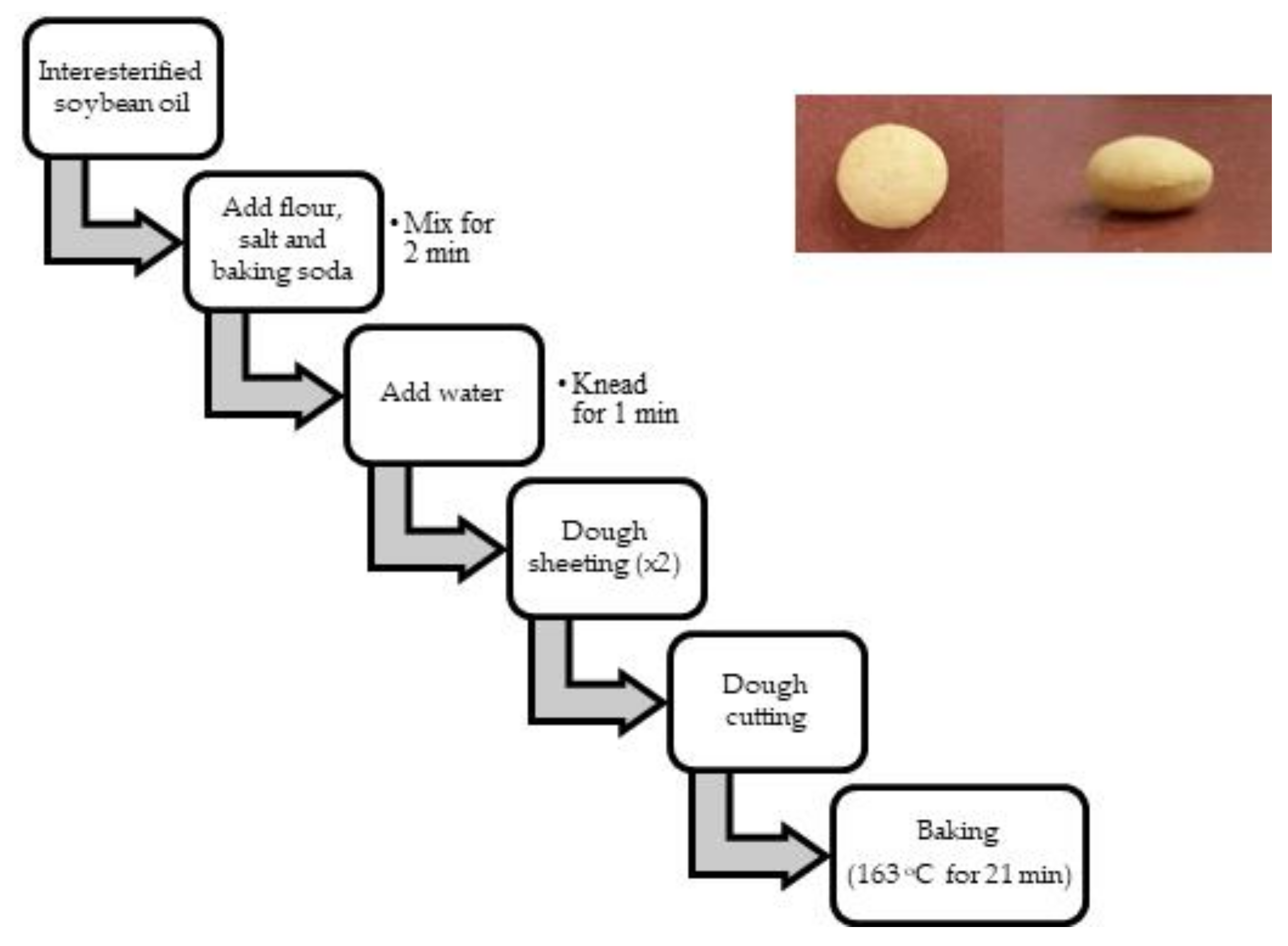
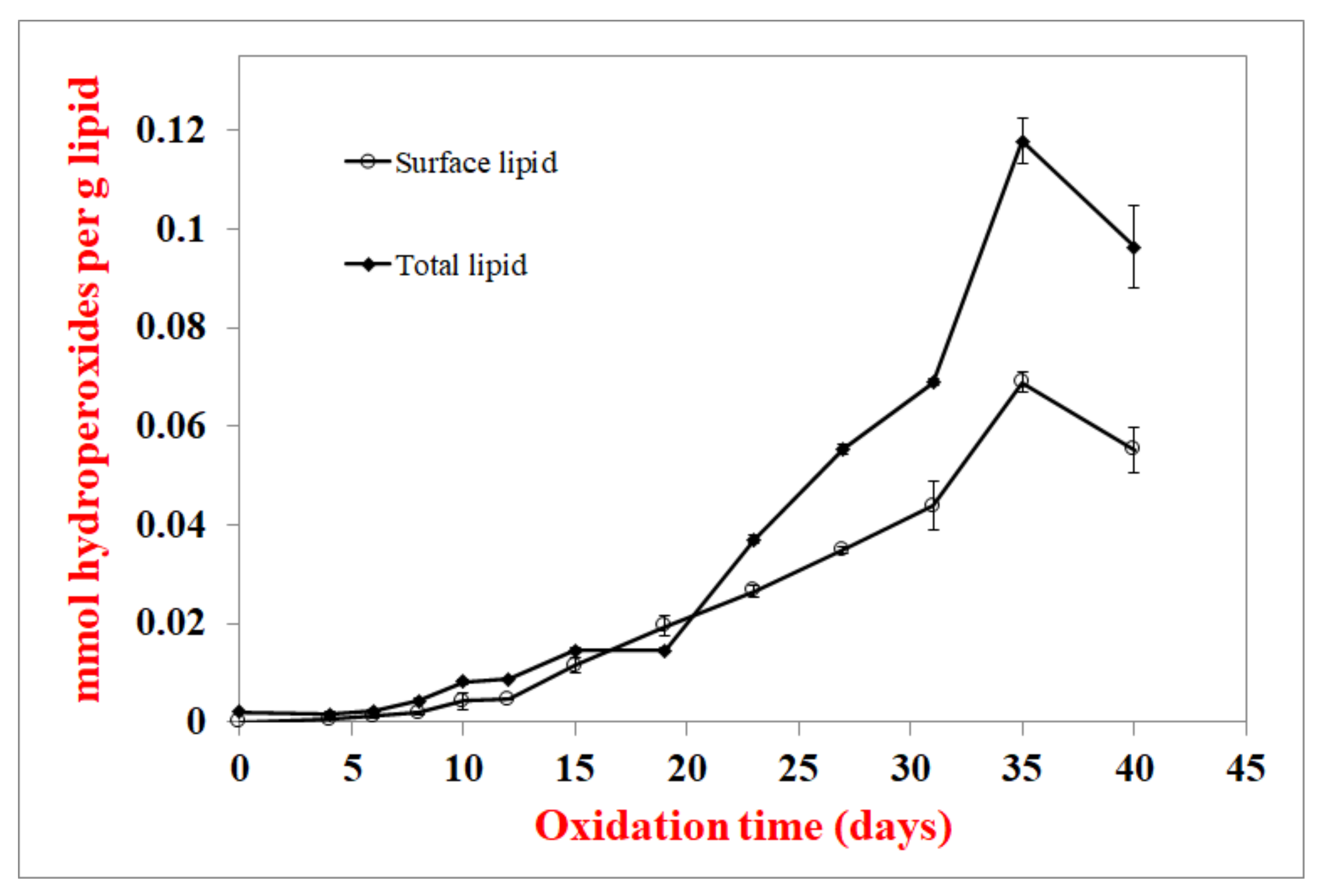
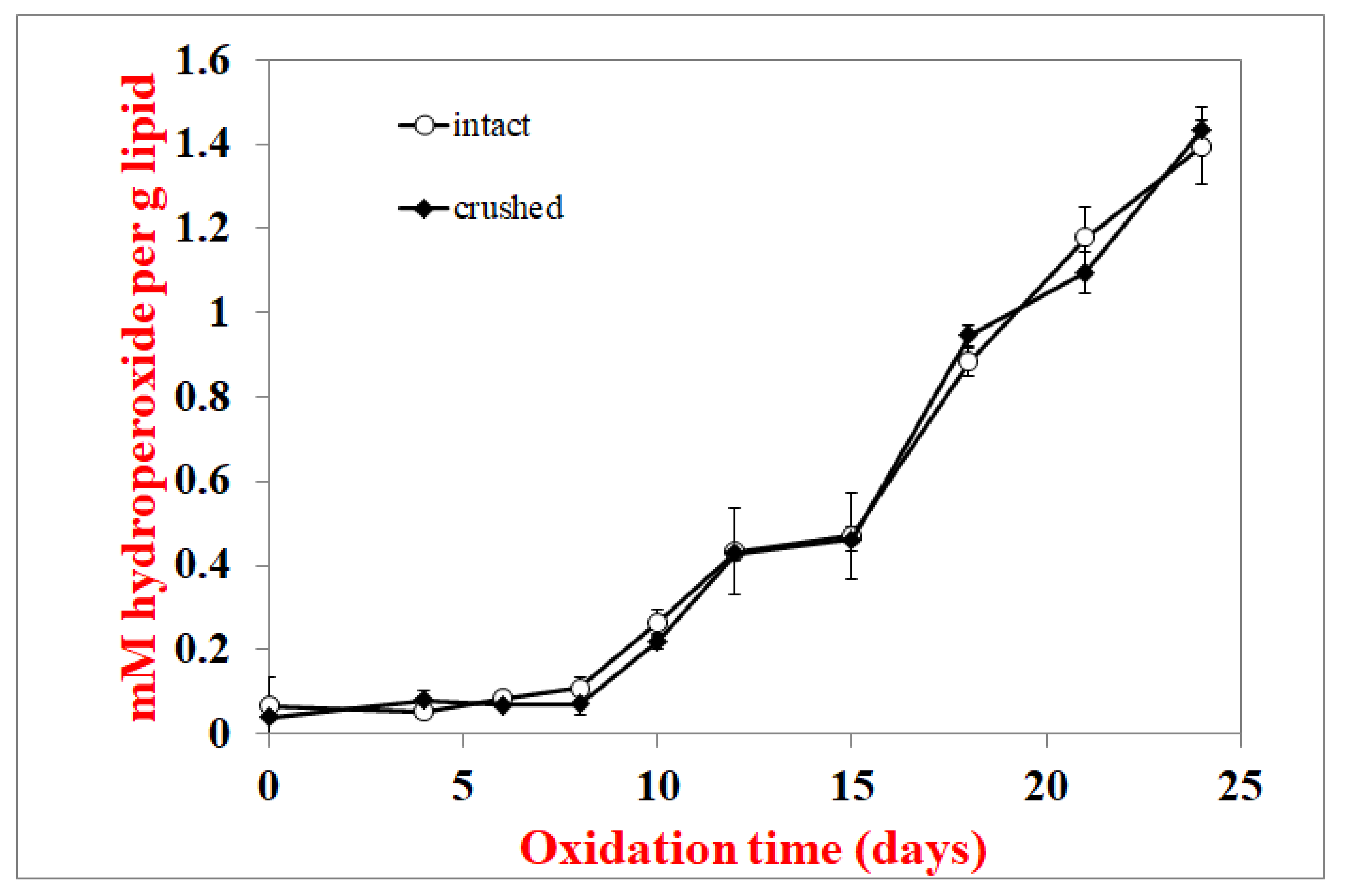
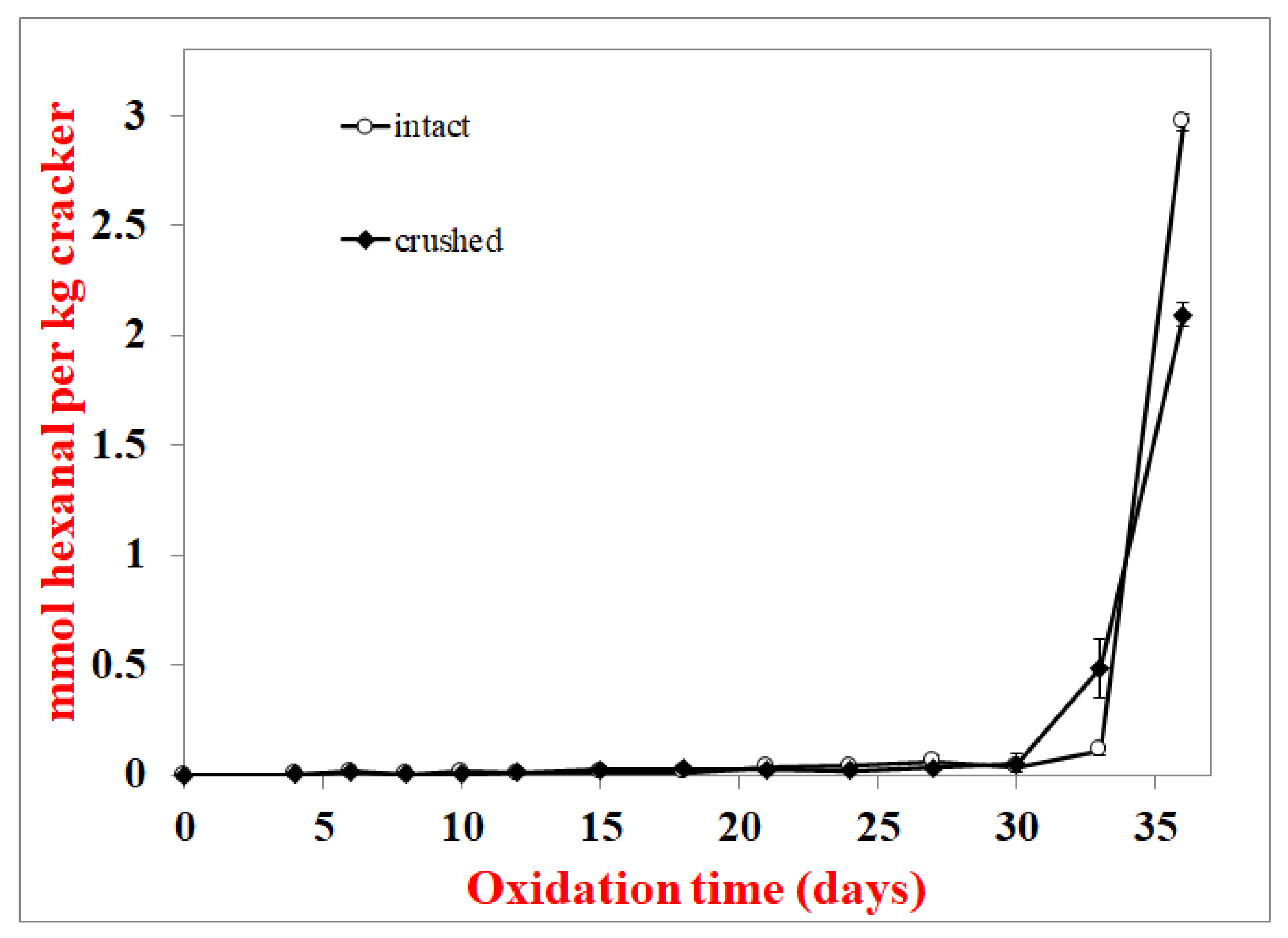
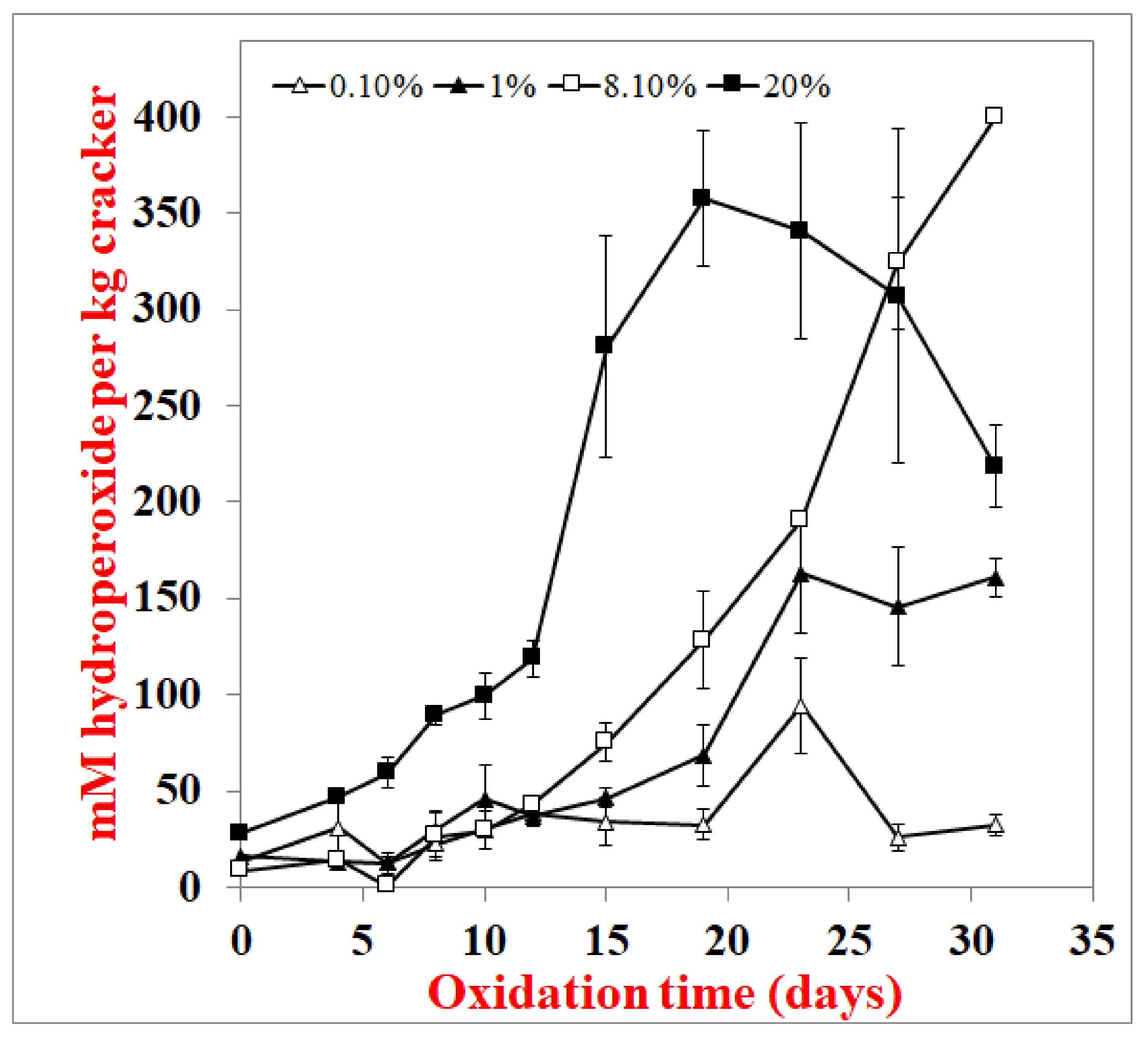
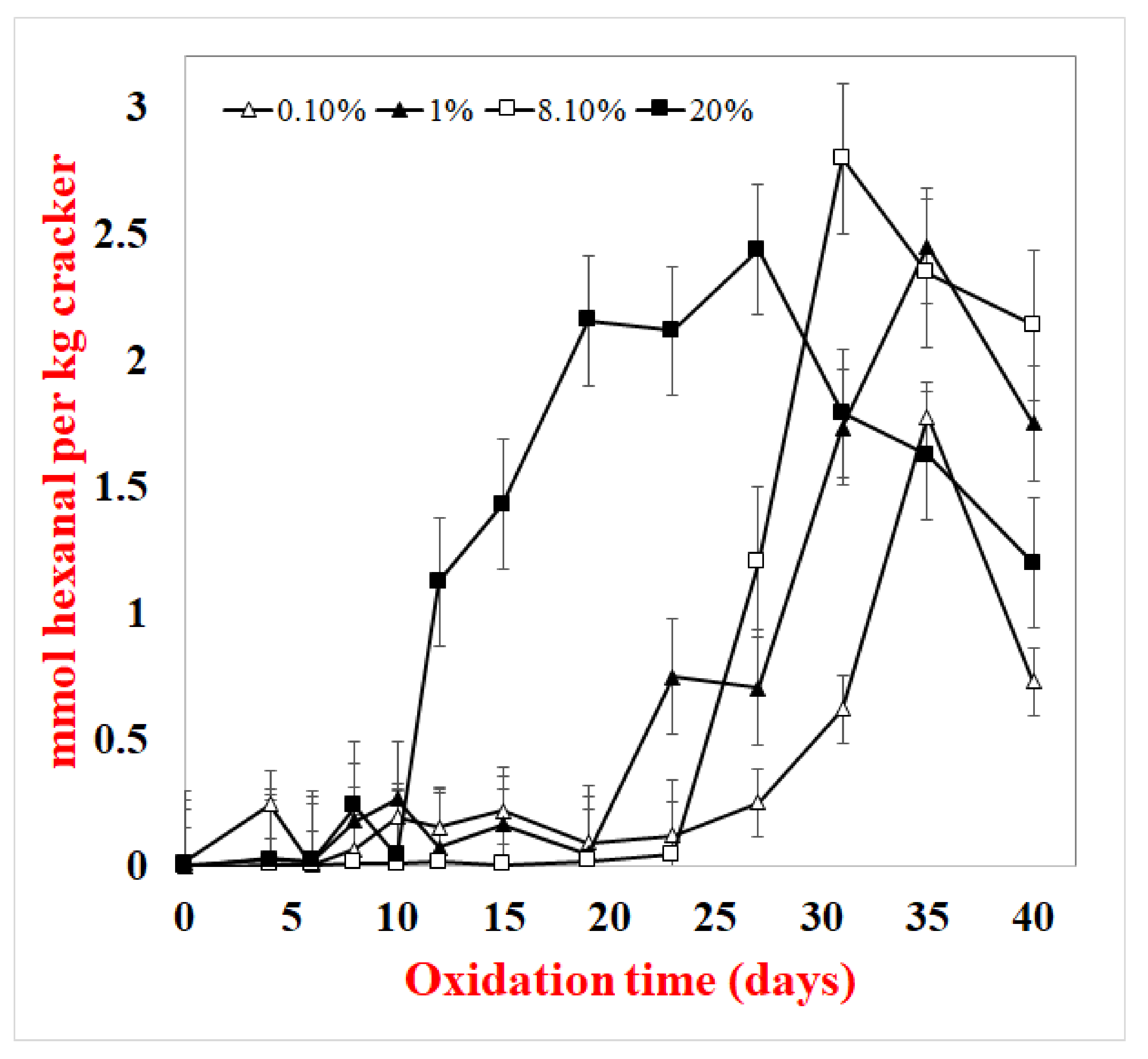
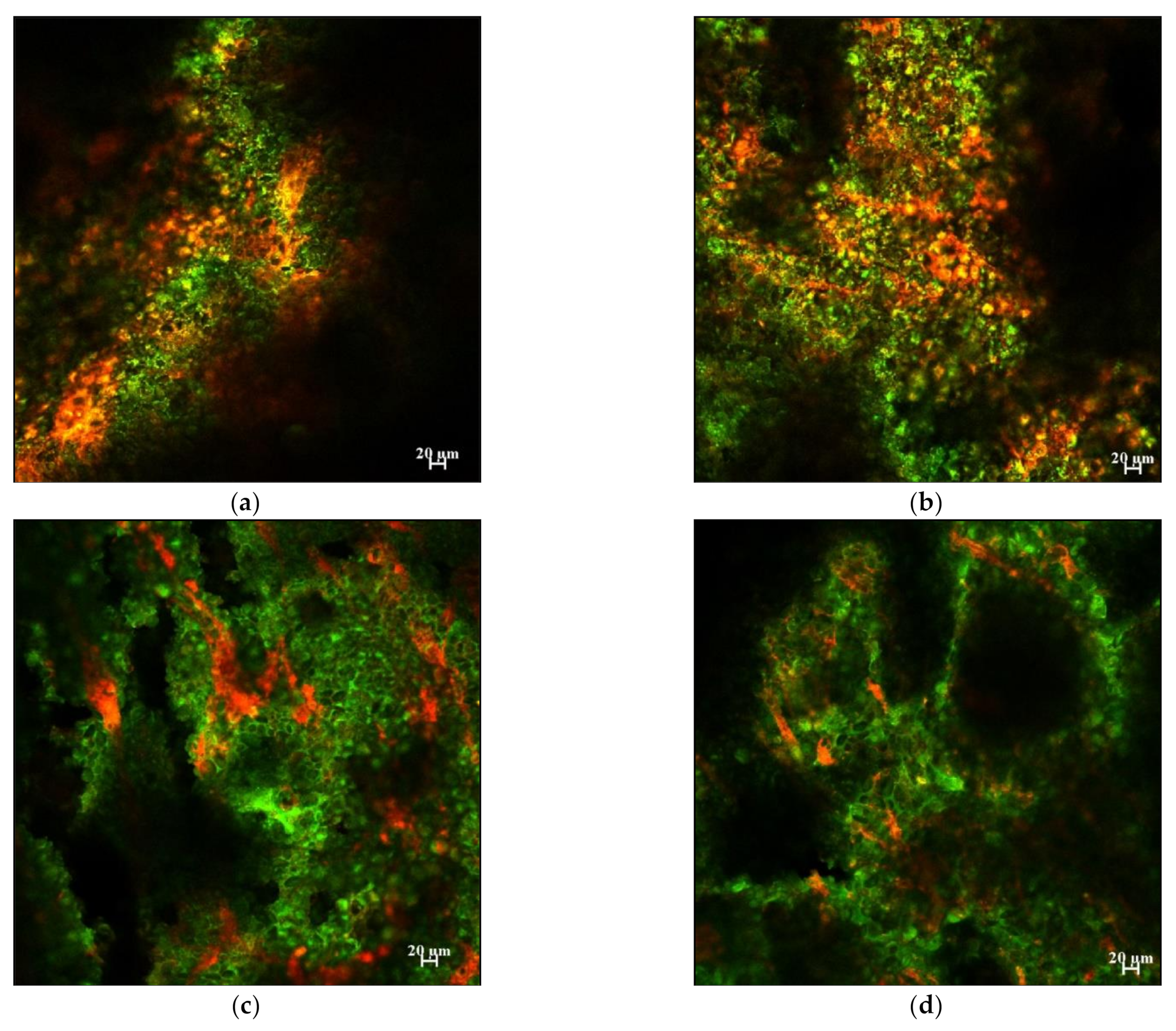
| Ingredient | 0.1% Fat | 1.0% Fat | 8.0% Fat | 20% Fat |
|---|---|---|---|---|
| Flour | 62.5 (50.6%) | 62.5 (50.6%) | 62.5 (50.6%) | 62.5 (50.6%) |
| DI Water | 48.82 (39.5%) | 47.82 (38.7%) | 39 (31.6%) | 24.30 (19.7%) |
| Interesterified Soybean Oil | 0.18 (0.1%) | 1.18 (1.0%) | 10 (8.1%) | 24.70 (20.0%) |
| Salt | 1.5 (1.2%) | 1.5 (1.2%) | 1.5 (1.2%) | 1.5 (1.2%) |
| Baking Soda | 0.58 (0.5%) | 0.58 (0.5%) | 0.58 (0.5%) | 0.58 (0.5%) |
| Flour for sprinkling on surface | 10 (8.1%) | 10 (8.1%) | 10 (8.1%) | 10 (8.1%) |
| TOTAL | 123.58 g | 123.58 g | 123.58 g | 123.58 g |
| Group | Water Activity ± Standard Deviation |
|---|---|
| 0.1% fat | 0.65 ± 0.04 |
| 1.0% fat | 0.23 ± 0.02 |
| 8.0% fat | 0.15 ± 0.03 |
| 20% fat | 0.10 ± 0.01 |
Publisher’s Note: MDPI stays neutral with regard to jurisdictional claims in published maps and institutional affiliations. |
© 2021 by the authors. Licensee MDPI, Basel, Switzerland. This article is an open access article distributed under the terms and conditions of the Creative Commons Attribution (CC BY) license (https://creativecommons.org/licenses/by/4.0/).
Share and Cite
Gumus, C.E.; Decker, E.A. Oxidation in Low Moisture Foods as a Function of Surface Lipids and Fat Content. Foods 2021, 10, 860. https://doi.org/10.3390/foods10040860
Gumus CE, Decker EA. Oxidation in Low Moisture Foods as a Function of Surface Lipids and Fat Content. Foods. 2021; 10(4):860. https://doi.org/10.3390/foods10040860
Chicago/Turabian StyleGumus, Cansu Ekin, and Eric Andrew Decker. 2021. "Oxidation in Low Moisture Foods as a Function of Surface Lipids and Fat Content" Foods 10, no. 4: 860. https://doi.org/10.3390/foods10040860
APA StyleGumus, C. E., & Decker, E. A. (2021). Oxidation in Low Moisture Foods as a Function of Surface Lipids and Fat Content. Foods, 10(4), 860. https://doi.org/10.3390/foods10040860







